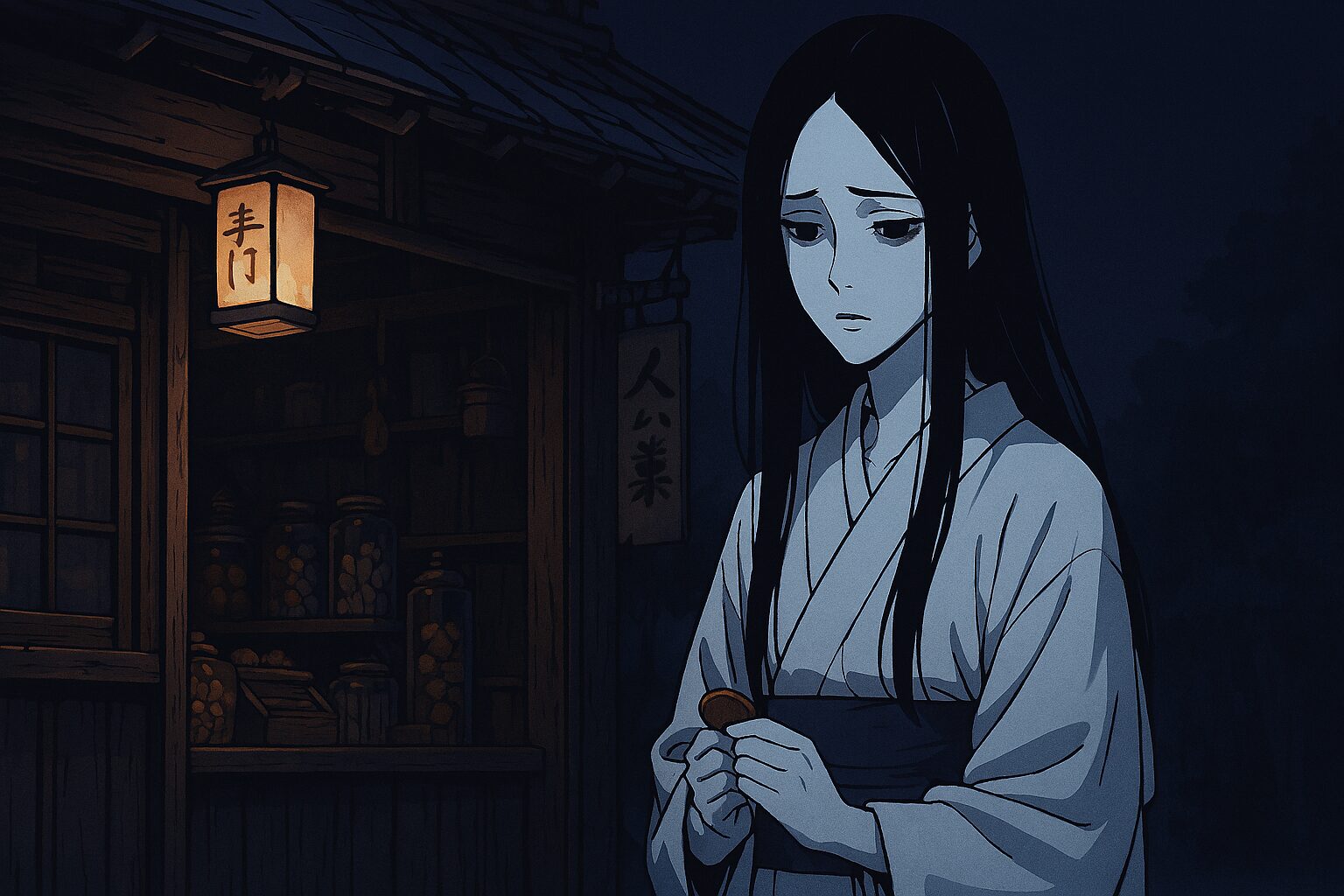The Child-Rearing Ghost: A Mother’s Tale Beyond the Grave
The Midnight Visitor
Long ago, in a certain town, there was a small candy shop. Late one night, after the shopkeeper had closed up and was preparing for bed, he heard a faint knocking at the door. “Knock, knock…”
Rubbing his sleepy eyes, the shopkeeper opened the door to find a young, beautiful woman standing there. Her face was pale, her kimono slightly disheveled, and her hair appeared damp. In a voice that seemed ready to fade away, she whispered:
“Please… please sell me one piece of candy.”
The shopkeeper found it strange, but he accepted the single coin she offered and handed her the candy. The woman nodded gratefully and vanished into the darkness of the night.
Coins of the Dead and Leaves
The next night, and the night after that, the woman appeared at the exact same time. “Candy, please…”
However, on the seventh night, the woman looked sorrowful. She said:
“I have run out of money. But I desperately need the candy. Would you please exchange this haori (jacket) for it?”
Moved by her desperation, the shopkeeper gave her the candy. Then, he realized something unsettling. When he checked the money she had paid on previous nights, he saw they were not ordinary coins. They were the old “Six Coins” (Rokumonsen) traditionally placed in a coffin for the dead. Furthermore, inside the bucket where he kept the money, shikimi leaves (leaves used in Buddhist funeral rituals) were mixed in with the coins.
A Cry from the Graveyard
“That woman… she may not be of this world.”
Driven by a mix of fear and curiosity, the shopkeeper decided to follow the woman as she left with the candy. She walked out of the town, along a lonely mountain path, and entered the graveyard of a nearby temple. There, in front of a mound of fresh earth—a new grave—she suddenly disappeared.
As the shopkeeper stood there trembling, he heard a faint sound coming from beneath the soil. It was the cry of a baby.
“Waaaah, waaaah…”
The Truth Revealed
The shopkeeper rushed to fetch the temple priest. After explaining the situation, they dug up the grave. Inside the coffin, lying next to the deceased mother, was a living baby.
The baby was sucking on the very candy the shopkeeper had sold. The mother had died while pregnant and was buried, but she had given birth inside the coffin. Since a deceased body cannot produce milk, her spirit had become a ghost, visiting the shop night after night to buy candy to keep her child alive.
It is said that the baby was then taken in by the temple, raised with care, and eventually became a high-ranking Buddhist monk.
Analysis: The Boundary Between Horror and Sorrow
This story possesses a unique structure that transcends the typical framework of “Kaidan” (Japanese ghost stories).
Why Candy?
In Japan at that time, candy (ame) made from malt was a highly nutritious food source. The choice of “candy” as a concrete and desperate means to feed a child, when a spiritual body cannot provide breast milk, adds a layer of poignant reality and demonstrates the mother’s tenacity.
Spending the Toll for the Afterlife
The “Six Coins” mentioned in the story are, in Buddhist tradition, the toll fee placed in the coffin for the deceased to cross the Sanzu River (similar to the River Styx) into the afterlife. The mother used this precious money not for her own salvation or safe passage, but to buy food for her child. This symbolizes the ultimate self-sacrifice: prioritizing the survival of the life left behind over the peace of her own soul.
Death and Motherhood in Japanese Culture
Reading “The Child-Rearing Ghost” reveals two deep layers of Japanese culture.
1. The Legend of Ubume
Japan has ancient folklore about the Ubume, a yokai (spirit) formed from a woman who dies in childbirth. While yokai are often depicted as harmful to humans, the mother in this story is a guardian. In Japan, ghosts and spirits are not always “evil”; they are often manifestations of strong emotions or “will.”
2. Obon and Ancestor Worship
Japanese people do not view the dead as being completely cut off in a separate world. During Obon, it is believed that ancestral spirits return home. The line between the living and the dead is blurred, and the sense that the deceased continue to watch over their families is deeply rooted in the modern Japanese mindset. In fact, a shop in Kyoto called “Minatoya Yurei Kosodate Ame Honpo,” which claims to be the setting of this legend, still exists today and has been operating for over 450 years. The legend lives on in reality.
A Question for You
How did this story make you feel?
If you were the candy shop owner and a pale woman visited you in the middle of the night, would you have the courage to follow her? or would you simply lock the door?
Does your culture have ghost stories that depict such strong maternal love? perhaps this mother, protecting her child even after death, represents a universal form of love.
I would love to hear your thoughts and reactions.
Related Information & Links
- Visit the Legend’s Setting (Kyoto): Kodaiji Temple Official Site – A temple deeply connected to this legend.
- Explore Traditional Kyoto: Kyoto City Official Travel Guide – Useful for finding historical shops and folklore spots.
- Read More Japanese Folktales: Japanese Folktale Series Category
日本の夏、あるいは雨の降る夜に語り継がれる物語があります。それは単なる怪談ではなく、死してなお消えることのない「愛」の物語です。今回は、日本各地、特に京都で有名な伝説「子育て幽霊(The Child-Rearing Ghost)」を紹介します。幽霊と聞くと恐怖を感じるかもしれませんが、この物語を読み終えたとき、あなたの心には温かいものが残るはずです。
子育て幽霊:死の淵を超えた母の物語
真夜中の訪問者
昔々、ある町に一軒の飴屋がありました。主人が店じまいをして寝静まった頃、戸を叩く音が聞こえました。「トントントン……」。
主人が眠い目をこすりながら戸を開けると、そこには若く美しい女性が立っていました。彼女は青白い顔をしており、着物はどこか乱れ、髪も少し濡れているようでした。彼女は消え入りそうな声で言いました。
「飴を……飴をひとつください」
主人は怪訝に思いましたが、彼女が差し出した一文銭を受け取り、飴を一つ渡しました。女性は嬉しそうに頷き、闇夜へと消えていきました。
六文銭と樒(しきみ)の葉
翌日の夜も、その次の夜も、女性は同じ時刻に現れました。「飴をください……」。
しかし、七日目の夜のことです。女性は悲しそうな顔をして言いました。
「お金がなくなってしまいました。でも、どうしても飴が必要なのです。この羽織と交換してくれませんか」
主人は彼女の必死な様子に心を打たれ、飴を渡しました。そして、ふとあることに気づきました。彼女がこれまでに支払ったお金を確認すると、それはただの小銭ではなく、死者の棺に入れる「六文銭」だったのです。さらに、お金が入っていた桶の中には、いつの間にか樒(しきみ:仏事に使われる植物)の葉が混ざっていました。
墓場からの泣き声
「あの女は、この世の者ではないかもしれない」。
恐怖と好奇心に駆られた主人は、飴を持って帰る女性の後をつけることにしました。女性は町を抜け、寂しい山道を通り、ある寺の墓地へと入っていきました。そして、新しい土盛りのある墓の前で、フッと姿を消したのです。
主人が震えながらその場に立ち尽くしていると、土の下から微かに赤ん坊の泣き声が聞こえてくるではありませんか。
「オギャア、オギャア……」
明かされた真実
主人は急いで寺の住職を呼び、事情を話して墓を掘り返しました。すると、棺の中で死んだ母親の横に、生きた赤ん坊がいたのです。
赤ん坊は、主人が売った飴をしゃぶっていました。母親は妊娠したまま亡くなり、埋葬された後に棺の中で出産したのです。しかし、死んだ母親には母乳が出ません。そのため、彼女は幽霊となって夜な夜な飴を買いに行き、我が子に与えて命を繋いでいたのでした。
この赤ん坊はその後、寺で大切に育てられ、名高い高僧になったと伝えられています。
物語の考察:恐怖と哀愁の境界線
この物語は、「怪談(Kaidan)」の枠組みを超えた、非常に特異な構造を持っています。
なぜ「飴」だったのか?
当時の日本において、飴は麦芽から作られる栄養価の高い食品でした。母乳が出ない霊的な身体であっても、子供に栄養を与えたいという具体的かつ切実な手段として「飴」が選ばれている点に、リアリティと母の執念を感じさせます。
三途の川の渡し賃を使わなかった理由
物語に出てくる「六文銭」は、仏教の教えで死者が三途の川を渡るための渡し賃として棺に入れられるものです。母親はその大切なお金を、自分の成仏のためではなく、子供の食料のために使い果たしました。これは、自身の魂の平安よりも、現世に残した子供の生存を優先したという、究極の自己犠牲を象徴しています。
日本文化における「死」と「母性」
「子育て幽霊」から読み解ける日本文化の深層には、二つの重要な要素があります。
1. 産女(Ubume)の伝承
日本には古くから、出産で亡くなった女性が妖怪「産女(Ubume)」になるという伝承があります。通常、妖怪は人間に害をなす存在として描かれますが、この物語の母親は、子供を守る守護者として描かれています。日本の妖怪や幽霊は、必ずしも「悪」ではなく、強い「想い(念)」が形になったものであると考えられています。
2. 盆と先祖供養
日本人は死者を完全に別世界の住人として切り離すことはしません。お盆(Obon)には先祖の霊が帰ってくると信じられています。死者と生者の境界線は曖昧であり、死者もまた家族を見守り続けているという感覚が、現代の日本人の精神性にも根付いています。京都には実際に、この伝説のモデルとなった「みなとや幽霊子育飴本舗」という店が実在し、450年以上も営業を続けています。伝説が現実に息づいているのです。
あなたへの問いかけ
この物語を読んで、あなたはどう感じましたか?
もしあなたが飴屋の主人だったとして、真夜中に青白い顔をした女性が訪ねてきたら、彼女の後を追う勇気はありますか?それとも、ただ扉を閉ざしますか?
また、あなたの国には、これほどまでに強い母の愛を描いたゴーストストーリーは存在しますか?死してなお子供を守ろうとするこの母親の姿は、世界共通の「愛」の形なのかもしれません。
ぜひ、あなたの考えをSNSやコメントで教えてください。
関連情報・リンク
- 伝説の舞台を訪れる(京都): 高台寺(Kodaiji Temple Official Site) – この伝説とゆかりの深い寺院です。
- 実際の飴屋を知る: Kyoto City Official Travel Guide – 京都の歴史ある店舗や伝説を探索するのに役立ちます。
- もっと日本の昔話を読む: Japanese Folktale Series Category


コメント